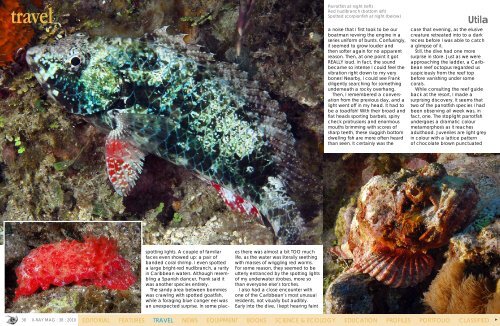Medium resolution version of X-Ray Magazine (96 dpi)
Medium resolution version of X-Ray Magazine (96 dpi)
Medium resolution version of X-Ray Magazine (96 dpi)
Create successful ePaper yourself
Turn your PDF publications into a flip-book with our unique Google optimized e-Paper software.
travel<br />
Parrotfish at night (left)<br />
Red nudibranch (bottom left)<br />
Spotted scorpionfish at night (below)<br />
a noise that I first took to be our<br />
boatman revving the engine in a<br />
series uniform <strong>of</strong> bursts. Confusingly,<br />
it seemed to grow louder and<br />
then s<strong>of</strong>ter again for no apparent<br />
reason. Then, at one point it got<br />
REALLY loud. In fact, the sound<br />
became so intense I could feel the<br />
vibration right down to my very<br />
bones! Nearby, I could see Frank<br />
diligently searching for something<br />
underneath a rocky overhang.<br />
Then, I remembered a conversation<br />
from the previous day, and a<br />
light went <strong>of</strong>f in my head. It had to<br />
be a toadfish! With their broad and<br />
flat heads sporting barbels, spiny<br />
check protrusions and enormous<br />
mouths brimming with scores <strong>of</strong><br />
sharp teeth, these sluggish bottom<br />
dwelling fish are more <strong>of</strong>ten heard<br />
than seen. It certainly was the<br />
Utila<br />
case that evening, as the elusive<br />
creature retreated into to a dark<br />
recess before I was able to catch<br />
a glimpse <strong>of</strong> it.<br />
Still, the dive had one more<br />
surprise in store. Just as we were<br />
approaching the ladder, a Caribbean<br />
reef octopus regarded us<br />
suspiciously from the reef top<br />
before vanishing under some<br />
corals.<br />
While consulting the reef guide<br />
back at the resort, I made a<br />
surprising discovery. It seems that<br />
two <strong>of</strong> the parrotfish species I had<br />
been observing all week was, in<br />
fact, one. The stoplight parrotfish<br />
undergoes a dramatic colour<br />
metamorphosis as it reaches<br />
adulthood. Juveniles are light grey<br />
in colour with a lattice pattern<br />
<strong>of</strong> chocolate brown punctuated<br />
spotting lights. A couple <strong>of</strong> familiar<br />
faces even showed up: a pair <strong>of</strong><br />
banded coral shrimp. I even spotted<br />
a large bright-red nudibranch, a rarity<br />
in Caribbean waters. Although resembling<br />
a Spanish dancer, Frank said it<br />
was another species entirely.<br />
The sandy area between bommies<br />
was crawling with spotted goatfish,<br />
while a foraging blue conger eel was<br />
an unexpected surprise. In some places<br />
there was almost a bit TOO much<br />
life, as the water was literally seething<br />
with masses <strong>of</strong> wriggling red worms.<br />
For some reason, they seemed to be<br />
utterly entranced by the spotting lights<br />
<strong>of</strong> my underwater strobes, more so<br />
than everyone else’s torches.<br />
I also had a close encounter with<br />
one <strong>of</strong> the Caribbean’s most unusual<br />
residents, not visually but audibly.<br />
Early into the dive, I kept hearing faint<br />
38 X-RAY MAG : 38 : 2010 EDITORIAL FEATURES TRAVEL NEWS EQUIPMENT BOOKS SCIENCE & ECOLOGY EDUCATION PROFILES PORTFOLIO CLASSIFIED
















